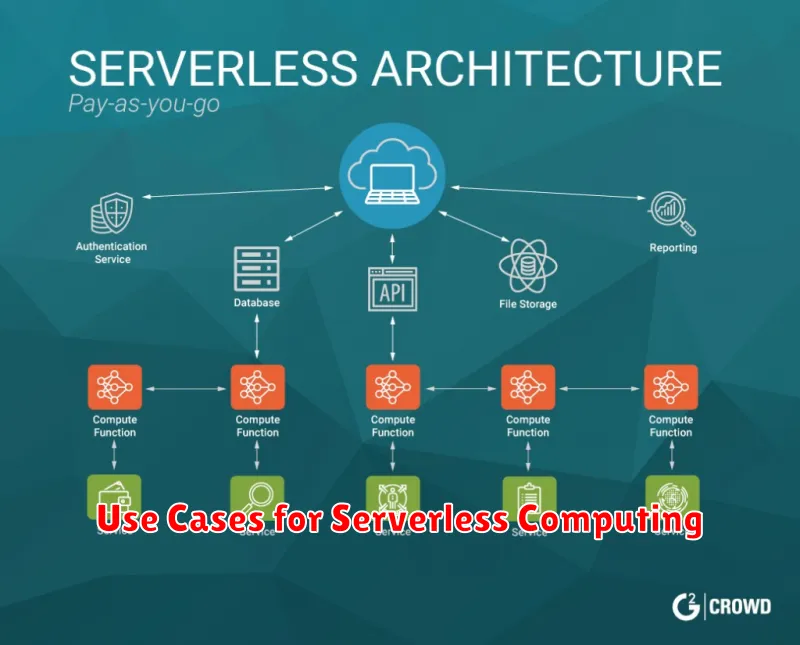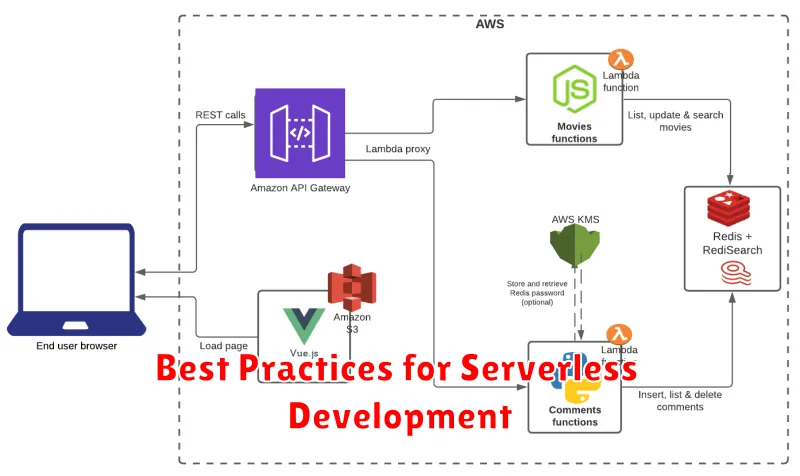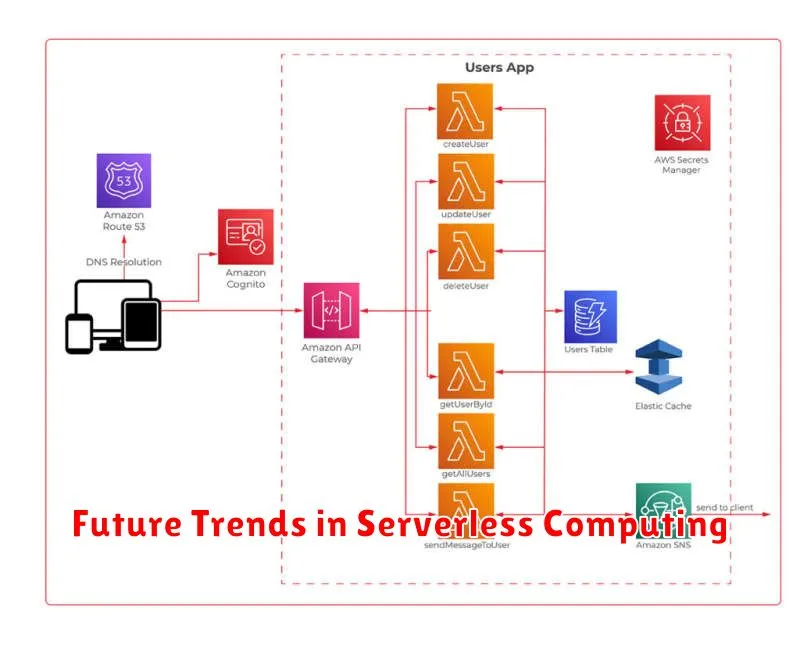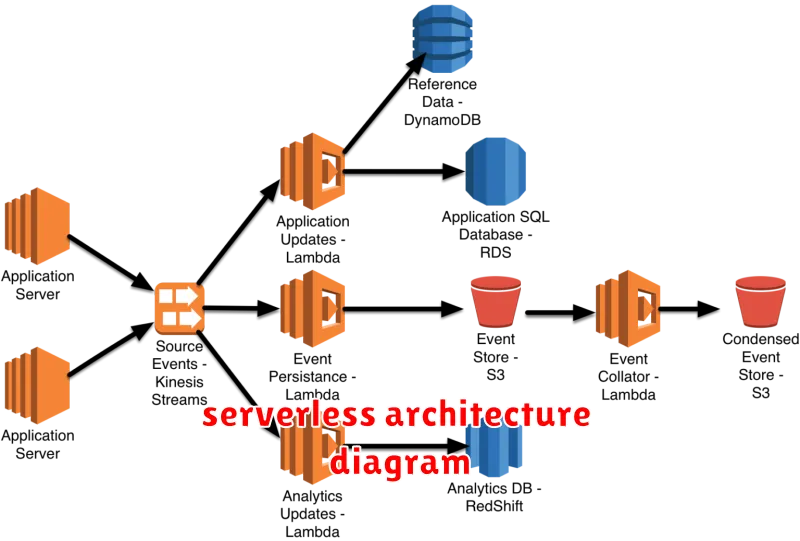In today’s fast-paced digital landscape, businesses are constantly seeking ways to enhance agility and scalability to stay ahead of the competition. Traditional infrastructure models often struggle to keep up with the demands of modern applications, leading to bottlenecks, increased costs, and slow development cycles. However, a revolutionary approach known as serverless computing is emerging as a game-changer, offering unprecedented levels of flexibility and efficiency. By abstracting away the complexities of server management, serverless platforms empower developers to focus on building innovative applications while seamlessly scaling to meet fluctuating demands.
The advantages of serverless computing extend far beyond mere infrastructure optimization. This paradigm shift unlocks a world of possibilities, empowering businesses to innovate faster, reduce costs, and optimize resource utilization. From streamlining development workflows to achieving lightning-fast scaling, serverless computing is transforming the way businesses operate in the digital age. In this article, we delve into the key advantages of serverless computing, exploring how it can help your organization unlock agility and scalability for unparalleled success.
Understanding Serverless Architecture
Serverless computing is a cloud-based execution model where the cloud provider manages the infrastructure, including servers, operating systems, and networking. Developers only focus on writing and deploying their code, leaving the complexities of server management to the cloud provider.
In a serverless architecture, applications are built as a collection of functions, independent units of code that respond to specific events or triggers. These functions are triggered and executed on demand, only consuming resources when actively in use.
This approach significantly differs from traditional application architectures where developers manage and maintain their own servers. Serverless computing eliminates the need for server provisioning, scaling, and maintenance, leading to enhanced agility and scalability.
Key elements of serverless architecture:
- Functions: Small, independent units of code that perform specific tasks.
- Events: Triggers that initiate function execution, such as HTTP requests, API calls, or scheduled events.
- Cloud provider infrastructure: The cloud platform manages servers, operating systems, and other infrastructure components.
- Auto-scaling: The cloud provider automatically scales resources based on demand, ensuring optimal performance and cost efficiency.
Benefits of Embracing Serverless
Serverless computing has emerged as a transformative paradigm, offering numerous advantages for businesses seeking agility, scalability, and cost optimization. By embracing serverless architectures, organizations can unlock a range of benefits that empower them to innovate faster and deliver exceptional user experiences.
One of the most significant benefits of serverless is its inherent scalability. Unlike traditional server-based models, serverless functions automatically scale up or down based on demand. This eliminates the need for manual provisioning and ensures optimal resource utilization, particularly during peak traffic periods. The ability to handle fluctuating workloads effortlessly translates to improved performance and reduced infrastructure costs.
Another key advantage is reduced operational overhead. Serverless platforms handle infrastructure management, security, and patching, freeing up developers to focus on building innovative applications. This simplified development process accelerates time-to-market and allows teams to deliver value faster. Moreover, the reduced operational complexity streamlines deployments and minimizes the risk of errors.
Serverless computing also promotes cost optimization. With a pay-per-use pricing model, businesses only pay for the resources they consume. This eliminates the need to invest in upfront infrastructure and reduces idle resource costs. As a result, serverless architectures can significantly lower overall expenses, particularly for applications with variable workloads or infrequent usage patterns.
Furthermore, serverless architectures encourage increased agility. Developers can deploy code independently, without worrying about server configurations or dependencies. This allows for faster iterations, rapid prototyping, and seamless integration of new features. The modular nature of serverless functions enables teams to work independently and deliver value incrementally.
In conclusion, embracing serverless computing offers a compelling set of advantages that empower businesses to achieve agility, scalability, and cost optimization. By adopting this transformative paradigm, organizations can unlock new possibilities for innovation, accelerate time-to-market, and deliver exceptional user experiences. The benefits of serverless are undeniable, making it a compelling choice for modern software development practices.
Cost Optimization with Serverless Computing
Serverless computing offers a compelling approach to cost optimization by allowing you to pay only for the resources you consume. This “pay-as-you-go” model eliminates the need for upfront investments in infrastructure, as you only incur costs when your code is actively running. Unlike traditional server-based architectures, where you are charged for the entire server even if it’s idle, serverless platforms dynamically allocate resources based on your application’s demand, ensuring efficient utilization and cost savings.
Furthermore, serverless computing empowers you to optimize your costs by leveraging the inherent scalability and elasticity of the platform. You can automatically scale your applications up or down to meet fluctuating demand, ensuring that you have the necessary resources without overprovisioning or underutilization. This dynamic scaling mechanism enables you to avoid unnecessary costs associated with maintaining idle servers or struggling with resource constraints during peak periods.
Cost optimization extends beyond infrastructure costs. Serverless platforms typically offer a wide range of managed services that streamline development and operations, further contributing to reduced expenses. These services include databases, messaging queues, and monitoring tools, eliminating the need for in-house maintenance and reducing operational overhead. By offloading these responsibilities to managed services, you can focus your resources on core business functionalities and maximize cost efficiency.
Enhanced Scalability and Flexibility
Serverless computing offers a paradigm shift in application development, enabling unparalleled scalability and flexibility. Unlike traditional infrastructure where resources are pre-allocated, serverless platforms automatically scale up or down based on real-time demand. This eliminates the need for manual resource management and ensures optimal performance even during peak traffic periods.
The inherent flexibility of serverless architectures allows developers to focus on building business logic without worrying about infrastructure complexities. Developers can easily scale their applications horizontally by simply adding more functions, while the underlying platform handles the resource allocation and management. This eliminates the need for complex configurations and allows for rapid experimentation and deployment of new features.
Furthermore, serverless functions are independent units, enabling developers to build and deploy components independently. This modularity allows for faster development cycles and easier maintenance. The ability to scale individual functions based on their specific needs further enhances efficiency and cost-effectiveness.
Faster Time-to-Market with Serverless
In today’s fast-paced digital landscape, businesses need to be agile and innovative to stay ahead of the competition. One key factor that can significantly impact a company’s success is its ability to bring products and services to market quickly. This is where serverless computing comes into play, offering a powerful solution for accelerating time-to-market and achieving greater agility.
Serverless computing allows developers to focus on building applications without having to worry about managing servers or infrastructure. This frees up valuable time and resources, enabling teams to iterate faster and deploy updates more frequently. With serverless, developers can easily scale their applications on demand, automatically adjusting resources based on real-time usage. This eliminates the need for manual scaling and reduces the risk of performance bottlenecks.
The pay-per-use pricing model of serverless computing also contributes to faster time-to-market. Businesses only pay for the resources they actually consume, eliminating the need to invest in expensive infrastructure upfront. This allows for a more efficient use of resources and can significantly reduce development costs. By eliminating the burden of server management, serverless computing enables teams to focus on core business objectives and accelerate the delivery of value to customers. With its inherent agility, scalability, and cost-effectiveness, serverless computing is a game-changer for businesses seeking to achieve faster time-to-market and stay ahead of the curve.
Focus on Innovation, Not Infrastructure Management
In today’s fast-paced digital world, businesses are constantly striving to innovate and stay ahead of the curve. However, the complexities of managing and maintaining traditional infrastructure can often be a major obstacle to achieving agility and scalability. This is where serverless computing comes in as a game-changer, allowing businesses to focus on their core competencies – innovation – rather than getting bogged down by infrastructure management.
With serverless computing, you don’t need to worry about provisioning, scaling, or maintaining servers. This frees up your valuable resources to concentrate on what truly matters: developing and deploying applications, enhancing user experiences, and exploring new business opportunities. Imagine a world where you can build and launch applications with unprecedented speed and efficiency, without the hassle of infrastructure management. Serverless computing makes this a reality.
By eliminating the need for infrastructure management, serverless computing empowers businesses to unlock a range of advantages:
- Increased agility: Quickly respond to market changes and deploy new features with minimal overhead.
- Enhanced scalability: Automatically scale your applications up or down based on real-time demand, ensuring optimal performance and cost efficiency.
- Reduced operational costs: Pay only for the resources you consume, eliminating the need for upfront investments in hardware and software.
- Improved developer productivity: Focus on building innovative applications rather than managing infrastructure.
Instead of spending valuable time and resources on infrastructure management, businesses can leverage serverless computing to embrace a future of continuous innovation. By focusing on what truly matters – building amazing applications and delivering exceptional customer experiences – companies can unlock their full potential and achieve unprecedented growth.
Improved Developer Productivity
Serverless computing empowers developers to focus on building applications rather than managing infrastructure. By abstracting away the complexities of servers, scaling, and maintenance, developers can dedicate more time to writing code and delivering value. This translates to faster development cycles, quicker iterations, and ultimately, increased productivity.
One of the key advantages is the reduced development overhead. Developers no longer need to spend time setting up and configuring servers, managing dependencies, or worrying about scaling. They can simply focus on writing code and deploying their applications with minimal effort. This streamlined workflow allows for faster iteration and experimentation, leading to faster delivery of features and bug fixes.
Furthermore, serverless computing fosters a culture of collaboration. With shared code repositories and automated deployment pipelines, developers can easily work together on projects, regardless of their location or expertise. This eliminates silos and accelerates development, allowing teams to deliver value quickly and efficiently.
Reduced Operational Overhead
Serverless computing significantly reduces operational overhead, freeing up your team to focus on what truly matters: developing innovative applications. By offloading infrastructure management and maintenance to cloud providers, you eliminate the need for server provisioning, patching, scaling, and monitoring. This translates to:
- Lower maintenance costs: No more investing in dedicated hardware or software for server management.
- Reduced staffing needs: Minimize the need for dedicated DevOps teams.
- Faster time to market: Spend less time on infrastructure management and more time building and deploying applications.
- Increased agility and scalability: Automatically scale your applications up or down based on demand, ensuring optimal performance and cost efficiency.
Seamless Integration with Cloud Services
One of the most compelling advantages of serverless computing is its seamless integration with cloud services. Serverless functions can easily access and interact with a wide array of cloud services, such as databases, storage, messaging queues, and APIs. This eliminates the need for developers to manage and maintain their own infrastructure, allowing them to focus on building and delivering applications quickly and efficiently.
This integration empowers developers to leverage the power of cloud services without the complexities of server management. For instance, a serverless function can easily connect to a cloud database to retrieve or store data, or it can communicate with a messaging queue to process events in real-time. This reduces the development overhead and allows developers to build sophisticated applications with minimal effort.
Furthermore, the pay-as-you-go pricing model of serverless computing encourages efficient use of cloud services. Developers only pay for the resources they consume, ensuring that they are only billed for the actual usage of cloud services. This cost-effectiveness further incentivizes developers to leverage the vast capabilities of cloud services, leading to more efficient and scalable applications.
Use Cases for Serverless Computing

Serverless computing, a powerful paradigm shift in cloud computing, empowers developers to build and deploy applications without managing servers. This approach offers unparalleled agility and scalability, making it ideal for a wide range of use cases.
Here are some prominent examples of how serverless computing shines:
Web and Mobile Backends:
Serverless functions are perfect for handling API requests, user authentication, data processing, and other backend tasks. This allows you to build scalable web and mobile applications without worrying about infrastructure management.
Event-Driven Architectures:
Serverless functions excel in handling real-time events, such as data updates, user actions, and system notifications. They can trigger actions based on these events, making them ideal for building highly responsive applications.
Data Processing and Analytics:
Serverless computing streamlines data processing tasks. You can leverage functions to analyze data streams, perform transformations, and generate insights in real-time, leading to quicker decision-making.
Microservices and API Development:
Serverless functions are a natural fit for developing microservices. Each service can be deployed independently, offering flexibility and scalability, making it easy to manage complex applications.
Image and Video Processing:
Serverless functions can efficiently handle computationally intensive tasks like image resizing, video transcoding, and object detection, delivering faster processing times and cost-effectiveness.
Serverless computing is rapidly expanding its reach, and as its capabilities continue to evolve, we can expect even more compelling use cases to emerge in the future.
Challenges of Serverless Adoption

While serverless computing offers compelling advantages, adopting it comes with its own set of challenges. One key hurdle is the shift in mindset required. Developers accustomed to traditional server management need to adapt to a new way of thinking about infrastructure and resource allocation. They must embrace the idea of functions as the core unit of execution and learn to optimize code for serverless environments.
Another challenge is the learning curve associated with serverless platforms. Understanding the intricacies of function execution, cold starts, and event-driven architectures can be daunting. Developers must invest time in learning new tools, frameworks, and best practices for serverless development.
Debugging and troubleshooting in serverless environments can be complex. Since functions are stateless and ephemeral, traditional debugging methods may not be effective. Developers need to leverage platform-specific tools and strategies for identifying and resolving issues.
Vendor lock-in is another concern. While serverless platforms offer flexibility, they are often tied to specific cloud providers. Switching platforms later could require significant effort and potentially introduce compatibility issues.
Finally, the cost model of serverless computing can be challenging to predict. While pay-per-execution offers cost savings for inactive periods, unpredictable usage patterns can lead to unexpected expenses. Organizations must carefully analyze their workloads and ensure they have appropriate cost management strategies in place.
Best Practices for Serverless Development

Serverless computing offers a compelling approach to building modern applications, boasting advantages like increased agility, scalability, and cost efficiency. However, harnessing these benefits requires embracing best practices that ensure smooth development and reliable operation. Here’s a guide to unlocking the full potential of serverless development:
1. Embrace the Serverless Mindset: The core principle of serverless development lies in shifting focus from managing infrastructure to building application logic. This mindset involves adopting a granular approach, breaking down applications into independent functions, and leveraging serverless platforms like AWS Lambda or Google Cloud Functions. This modularity fosters scalability, simplifies deployment, and reduces operational overhead.
2. Design for Event-Driven Architecture: Serverless architectures excel in handling events triggered by various sources, such as API calls, database changes, or message queues. Embrace this event-driven nature by designing your application’s flow around events. This allows your functions to respond to specific actions, improving efficiency and scalability.
3. Optimize for Cold Starts: Cold starts occur when a function is invoked for the first time, requiring initialization and loading. Minimize their impact by optimizing function size, reducing startup time, and leveraging pre-warming techniques, where functions are periodically invoked to keep them warm and ready to handle requests.
4. Prioritize Security: Security in serverless environments is paramount. Implement strong authentication and authorization mechanisms, utilize role-based access control, and leverage serverless security services offered by cloud providers. Regularly audit security configurations and keep your dependencies updated to mitigate vulnerabilities.
5. Leverage Monitoring and Logging: Thorough monitoring and logging are essential for understanding function performance, identifying bottlenecks, and troubleshooting issues. Utilize cloud provider tools for monitoring, implement custom logging mechanisms, and integrate with observability platforms for centralized data analysis and alerts.
6. Embrace DevOps Practices: Serverless development thrives on automation and continuous integration/continuous delivery (CI/CD). Implement automated testing, code deployments, and monitoring processes to ensure seamless updates and operational stability. Leverage serverless-specific tools and platforms to streamline your DevOps workflow.
By adhering to these best practices, developers can unlock the full potential of serverless computing, building agile, scalable, and cost-effective applications that thrive in the modern cloud environment.
Future Trends in Serverless Computing

Serverless computing, a revolutionary approach to software development, has gained immense popularity in recent years. This paradigm shift, where developers focus solely on writing code without managing infrastructure, unlocks unprecedented agility and scalability. As serverless computing continues to evolve, exciting trends are emerging that will further redefine the landscape of application development.
Serverless-First Development
The future of serverless computing lies in the adoption of a serverless-first development approach. This means that applications are designed and built with serverless architecture as the primary consideration. Developers will leverage serverless frameworks, tools, and best practices to ensure optimal performance, scalability, and cost-efficiency from the ground up.
Edge Computing Integration
The convergence of serverless computing with edge computing is poised to revolutionize application deployment and performance. Edge functions, which are serverless compute instances deployed at the edge of the network, will enable applications to respond faster, reduce latency, and deliver a more seamless user experience, especially for geographically distributed users.
Advanced Serverless Platforms
Serverless platforms are continuously evolving to provide developers with more sophisticated features and capabilities. Expect to see advancements in areas such as serverless databases, serverless machine learning, and serverless data analytics. These advancements will empower developers to build even more complex and data-driven applications in a serverless environment.
Enhanced Security and Governance
As serverless computing gains wider adoption, security and governance become paramount. Serverless platform providers will continue to invest in robust security features, access control mechanisms, and compliance certifications to ensure that serverless applications are protected from threats and adhere to industry regulations.
Conclusion
Serverless computing is not just a trend but a transformative force that is reshaping the future of software development. The trends outlined above point to a future where serverless becomes even more powerful, flexible, and accessible. By embracing these advancements, developers can unlock unprecedented levels of agility, scalability, and innovation, driving the next generation of applications.

